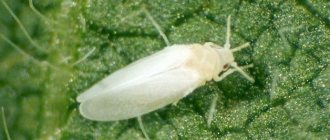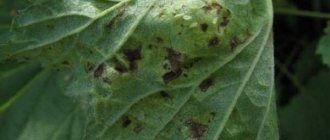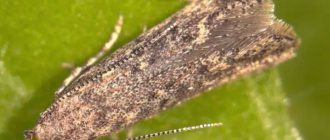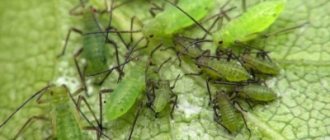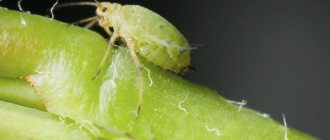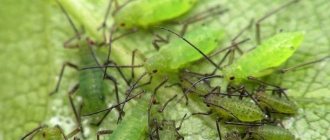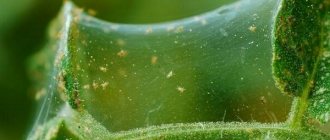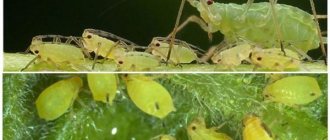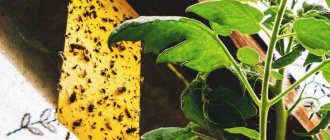Tomato beds often attract pests. The most dangerous of them is considered to be the whitefly - it sucks the juice of the plant, which leads to its drying out and death. Both adult moths and larvae are pests.
What to do if there are white midges on tomatoes, how to deal with them, and what measures can be taken to protect the crop from pests - you will learn all this from our article.
General information and damage from insects
There are several species of midges that are not averse to eating tomatoes.
The main enemies of the culture are black and white midges. Each of them has its own characteristics. The second name for black midge is soil fly or winged aphid. An adult grows up to 2, sometimes up to 4 mm in length. It has a black body and transparent wings. It reproduces in moist soil enriched with organic matter. The larvae live in the upper layers of the soil. After pupation, they cause harm by eating the roots of nearby plants. Adults feed on the sap of cultivated and weed seedlings, hiding on the underside of the leaves. A large number of black midges on tomatoes leads to wilting of plants, stunted growth and lack of fruiting.
Black midges on a tomato leaf
White midges on tomatoes are small whitefly moths. Insects grow up to 3 mm. Midge larvae are laid on the bottom of leaves and on stems. This allows them to maintain their vital functions by saturating the plant with juice and nutrients. After such an invasion, the greens and fruits of tomatoes are damaged and begin to turn black. Even a drop in temperature does not lead to the death of pests. They overwinter in the top layer of soil.
Midges reproduce quickly enough to cause unique damage to plantings in a short time. In addition, pests are carriers of viruses and leave on tomatoes a favorable environment for the proliferation of fungi. Failure to take timely measures to destroy insects will lead to the loss of almost half of the crop.
What to do if there are midges in the seedlings
So, when you notice midges on seedlings, try to get rid of them as quickly as possible, using various methods. Sometimes you have to use several methods at once when the number of insects is quite large. But in any case, the very first thing to do is dry the top layer of soil. To do this, take the containers to a sunny, warm place and do not water the seedlings for several days. If there are not many midges on the seedlings yet, try using folk remedies.
How to kill midges - folk methods
There are many traditional methods; you can choose one, or combine two or three methods.
other methods
Insecticides against midges on seedlings
If the situation with midges has already progressed to such an extent that it cannot be corrected with the help of folk remedies, you will have to resort to stronger means and use potent insecticides. Just remember to ventilate the room well after treatment.
Means for treating midges on seedlings:
When using chemicals, read the instructions before use; some products will require re-treatment.
Fumigators
When there are a lot of seedlings and there is no way to quickly process them, fumigators with volatile preparations will come to the rescue. The principle of their operation is simple. The device is plugged into the electrical network. The plates or liquid that are installed inside the device heat up. When they evaporate, they release an insecticide that has a detrimental effect on all types of insects.
When using the plates, they are changed every 10-12 hours. Replacing them is easy; you just need to remove the used plate from the special connector and insert another one.
Fumigators, into which a bottle of liquid is inserted, allow you to use the device for several days without losing its insecticidal effect.
Life cycle and distribution
Due to their rapid reproduction, midges can produce up to 5 generations in one season. Thanks to the ability of some species to fly, they easily move from one bush to another and so on throughout all tomato beds. The life cycle of whiteflies depends on the presence of ants nearby. At night, anthills provide shelter for pests. This is where they lay their eggs. White midges do not have good flight ability, but in case of danger they can quickly move to a more secluded place, where they accumulate in large numbers.
Insects lay eggs in the spring, when the ground has warmed up sufficiently. White midges breed on tomatoes in a greenhouse all year round. The larvae are born within a week after laying. Having found a secluded place, they pupate and within two weeks become invulnerable to chemicals and other treatments. After a while, adult individuals emerge from the cocoons and begin active reproduction. The full development cycle is 25 days, and the lifespan of one female is about 30 days. During her life she manages to lay about 140 eggs.
Whitefly butterfly
Folk recipes
When midges appear on tomatoes, it is not always necessary to use toxic substances. In some cases, folk remedies and methods are quite effective. The simplest of them involves the use of low temperatures. Simply take the midge-infested tomatoes outside and leave them until the morning.
Important! This method is only suitable for cold-resistant varieties, and such an event can be carried out in early spring, when the air temperature is still quite low. And when the thermometer drops below +15°C, the whitefly will die!
On a note! The soap solution does a great job even with numerous colonies of white midges on tomatoes!
Signs of appearance in the garden plot
Finding out that midges have infected tomatoes is quite simple. Small black or white insects will fly around the bushes. In addition, there are other signs:
- defects will be clearly visible on the plants: the leaves will curl into tubes, become dry and covered with a white coating;
- the stem and shoots may turn yellow;
- the fruits will stop developing, the yield will be greatly reduced;
- ant trails will be visible, because these insects feed on the waste products of midges.
If at least one of the above signs appears, you need to immediately begin the fight against midges.
Reasons for appearance
Having gotten rid of midges on seedlings once, you may encounter this problem more than once in the future. Therefore, it is important to know what causes them to appear.
Among the common reasons:
- overflow Growing tomatoes or peppers simply cannot cope with large amounts of moisture;
- contaminated land. Midges on seedlings do not appear out of nowhere; most likely, you bought packaging that did not undergo the necessary disinfection from insect eggs;
- lack of free air circulation. Saving space and large grouping of seedlings does not lead to good results;
- poor-quality composition of the soil with a large amount of unrotted organic matter. This is an excellent breeding ground for the development of midges;
- active use of organic fertilizers. Knowing gardeners, it is easy to suspect them of feeding with infusions of natural origin. Flower growers are also not lagging behind and fertilize the pots with the most unpredictable food scraps.
The main reason, of course, is overflow. It is enough to overdo it with water once and the contaminated or heavy soil will become infested with midges and their larvae (which have recently hatched from eggs laid by adults). The same goes for air circulation. Having identified the main reason for the free movement of midges over seedlings, it will be much easier to fight them.
Why white midge appears on tomatoes and how to get rid of it
Whiteflies often attack tomatoes grown in greenhouses or greenhouses. Insects appear when it rains frequently. The moth looks like an ordinary midge, only white. The pest most often appears in mid-summer under favorable conditions - high humidity and high air temperatures.
A gardener may not immediately recognize that pests have appeared on his site - whiteflies choose to live on the lower leaves of a plant or hide on their insides.
You can save the entire crop from white midges if there are only moths on the plants without larvae. The fight against small pests needs to be approached comprehensively.
The most common ways are:
- fumigation;
- chemical treatment;
- biological drugs;
- bait.
Prevention
To destroy white midges on tomatoes, you will need to spend a fairly long period of time, and when using insecticides, you can harm both yourself and the plantings. It is much easier and better to carry out proper prevention.
- Since the whitefly dies at +15°C, greenhouses should be ventilated more often in early spring - this measure will significantly reduce the risk of the parasite appearing.
- In addition, it is necessary to regularly weed the plantings, removing weeds and tomato tops.
- Dig up the beds, treat the metal elements of greenhouses with soapy water from time to time, and do not store compost in the garden.
These simple measures will be quite enough to make tomato plantings unattractive to white midges. Have a good harvest!
The main signs of the appearance of black midges
One of the signs that tomatoes have been attacked by aphids (small black midges) is wilting of the leaves. Many people decide that the plant does not have enough moisture and water it abundantly. If the pests appeared a long time ago, then dark spots appear on the stem, which over time turn into a dry brown crust.
Tomato leaves wither and curl
This signals that the plant needs to be carefully inspected. Most often, a small pest with wings can be found in the lower part or axils of leaves. With an inexperienced eye, aphids may not be immediately visible, so it is better to inspect during the day when the sun is shining brightly.
If aphids are not found on one of the wilting tomatoes, inspect all the plants. Even without seeing pests, it is better to carry out preventive treatment, this will ensure that undetected individuals will disappear.
Another sign of black midges appearing on tomatoes is a large number of ant trails near the garden bed. Ants protect aphids, because the sweet liquid secreted by pests is the best food for them.
How to determine the presence of this parasite?
You are a wonderful owner, the soil in the beds is loose and moist. So why do your tomatoes look so sad? Most likely they were attacked by aphids. Colonies of black midges occupy the tops of young shoots and actively colonize the underside of leaf blades. Ants scurrying around tomato bushes can be a harbinger of an aphid attack. After all, aphids are literally a delicacy for ants. In order to obtain a sugar-containing waste product - honeydew, ants carry aphids to new pastures - young plant leaves, protecting them from predators.
When changing their place of residence, ant families always take aphids with them so as not to be deprived of an uninterrupted source of sugars. And of course, they colonize plants near the anthill. Aphids reproduce very quickly; in a month, one midge produces several hundred thousand new individuals. Among them there are winged ones that fly long distances. Aphids feed on plant juices, piercing the surface of leaves and young shoots with their proboscis. They can completely destroy a young plant. A more mature plant slows down its growth, the leaves curl, the fruits become smaller, and ovaries do not form in place of the eaten flowers. Aphids not only deprive the plant of vital juices, but also infect it with viral diseases.
Why do midges appear on tomatoes?
When small midges appear on tomatoes, it is necessary to react as quickly as possible and take measures to destroy the pest. These insects appear and also actively spread in high humidity and extreme heat. This environment is created by inexperienced gardeners or in a greenhouse.
Black and white insects cause equally great damage to plants; in addition, they are quite difficult to fight, especially in advanced cases.
The midge reproduces incredibly quickly, it attacks all the green parts of the plant, sucking the juices out of it, and having destroyed one bush, it immediately moves to the next. There are several varieties of this pest, but all belong to the same species - aphids.
Briefly about tomatoes and their pests
Modern varieties are unpretentious and produce a rich harvest with minimal effort. But caring for a tomato requires knowledge and skills. Difficulties begin from the first days of growing seedlings. A little later, gardeners have another headache - how to get rid of pests and prevent diseases with the help of drugs or folk remedies.
Tomatoes belong to the nightshade family, which is loved by many insects and pathogenic bacteria . The latest are:
- Blackleg. First, the root collar becomes dark in color, then rots, which leads to thinning of the stem and death of the plant. The disease spreads quickly and can destroy a plantation in a short time.
- Late blight affects leaves and fruits, which dry out and rot. When infected, it can destroy 80% of all plants.
- Brown spotting appears when there is high humidity or low temperature. This is a fungal disease. The spores are easily transferred and can persist in the soil for a long time. Symptoms include brown spots on the undersides of leaves with a gray coating.
- Mosaic, which cannot be treated, is one of the most dangerous diseases of tomatoes. When infected, pigment spots are formed that resemble a mosaic. Next, the tomato leaves curl and wrinkle, and the bush withers before our eyes.
- Gray and brown rot , the appearance of which is promoted by coolness and humidity. A tomato is infected if first small and then large watery spots are noticed on the fruit.
As for pests, the most dangerous ones include:
- nematodes that damage roots;
- spider mite;
- scoop caterpillars that spoil the above-ground parts;
- sprout fly that attacks tomato seedlings. The eggs are in the ground, and with the heat, larvae appear, damaging the sprouts.
In addition, the Colorado potato beetle and aphids can spoil the tomato harvest.
How dangerous are insects?
In addition to the fact that black flies on tomatoes in a greenhouse or open ground are capable of sucking out all the juices, curling the leaves, and destroying the ovaries, they can infect all plants with other dangerous diseases.
Young plants are most susceptible to attack; they have not yet grown strong, and the roots have not gained strength. Fungal and bacterial infections, along with aphids, will completely destroy the plant.
Parasites are dangerous for tomatoes not only in adulthood. At the larval stage, they secrete a sticky, waxy liquid that prevents the plant from developing normally. As a result, it becomes more difficult to control aphids.
For an adult, strong tomato bush, aphids are not so terrible; it is difficult for the insect to bite through the hardened parts of the plant. However, mature fruits may suffer and develop unsightly black spots caused by insect waste.
Preventive measures to prevent the appearance of whiteflies on tomatoes
To prevent whiteflies from appearing in a greenhouse with tomatoes, you must follow certain rules. Their strict implementation will help avoid pest attacks and also guarantee a good harvest. It is easier to prevent any problem than to fix it later.
- The greenhouse should be cleaned and disinfected every fall and/or spring.
- Ensure adequate ventilation in the greenhouse.
- Carry out preventive measures and use special protective equipment.
By following all the recommendations and rules for growing tomatoes in a greenhouse, you don’t have to worry about this malicious pest. But if whiteflies appear on tomatoes, you should not postpone treatment until later, since in this case the days count. As a result of delay, plants lose immunity, which subsequently negatively affects the harvest.
Types and signs of parasitism
Small insects can cause irreparable damage to crops both outdoors and in the greenhouse. You should inspect the plants daily, paying especially close attention to young seedlings, which quickly die when attacked by midges of any variety.
On tomatoes, two similar species are most often found - white aphids and black aphids. They differ in color and body structure, but they cause equally strong damage. To determine the infestation and take action in time, the easiest way is to shake the tomato bush, then the midge will fly into the air.
White midges whiteflies
On the bottom of the leaf it is easy to notice small white flies - these are whiteflies. They have transparent wings, the body is less than 3 mm. These insects jump and fly well, so they quickly infect plantings.
Most often this pest appears in greenhouses, although it is also found in open plantings. Like other types of aphids, the whitefly sucks the juices from the plant, resulting in curling of the leaves, drying out of individual parts, falling flowers, or the absence of ovaries on tomatoes altogether. In addition, black or brown spots appear.
Black
Black midges on tomatoes are common and multiply incredibly quickly. Tomato aphids are a little different, as there are many varieties. Regardless of the presence of wings or size, the insect quickly destroys the plantings and the plants die.
Dark midges are much smaller, their body grows no more than 2 mm in length, and up to 5 generations of insects are born in one season. Aphids lay eggs for the winter in old bark, foliage, and other secluded places. At the same time, they are not afraid of frost. In the spring, larvae hatch from the clutch, develop quickly, and reproduce without fertilization at high speed.
Signs of infection
On tomatoes, white midges only appear in the greenhouse, and infected plants are quite easy to recognize. The leaves are yellow and curled, fruit development is uneven, and their internal tissues turn white.
Recommendation! And to make sure that you are really dealing with a whitefly, just touch the affected bush - the small midge will immediately rise into the air.
In the course of their life, insects secrete a transparent secretion that can be found on the upper surface of the leaves. After some time, this plaque darkens and turns black. These are sooty fungi called black fungi. Gradually, the black coating spreads to the stem and fruit, which spoils their appearance and has a detrimental effect on the quality of the crop.
At the same time, mobile is far from the only disease that midges can “award” to tomatoes. In addition to it, this pest also carries some viral diseases, including leaf curl, chlorosis and jaundice. As a result, the leaves are deformed, necrosis of the stem tissue and fruits of the plant develops, and shoot growth is noticeably slowed down.
It is worth noting that it is the whitefly larvae that cause the greatest harm. And if only adult individuals were found on tomato bushes, this means that no serious damage has yet been caused to the tomato plantings.
Important! However, even in such a situation, it is necessary to select a drug that will prevent the active reproduction of pests and protect the harvest!
What to do with white insects?
Small white insects on tomato bushes are whiteflies. It starts mainly in a greenhouse, since there are all the conditions for it: warmth and moisture. The whitefly is a small butterfly with transparent wings, its size reaches about 3 millimeters. It can be seen on the back side of the leaf plate. In favorable conditions, it actively reproduces, which can subsequently lead to the inevitable death of the cultural planting.
Already formed insects and their larvae feed on plant juices. Subsequently, a white sticky coating can be observed on the foliage of tomatoes - a product of the vital activity of parasites. In addition, the leaves begin to curl and turn yellow, and the fruits ripen unevenly.
The whitefly not only sucks plant juices, but also introduces a dangerous infection called sooty fungus. The disease contributes to disruption of leaf assimilation. The foliage of a diseased plant begins to turn black, dry out, and with the active development of the disease, if it is ignored, the fruits begin to slow down in development and growth, and also stop forming. Subsequently, the bush simply dies.
Fumigation
Fumigation is usually carried out only in greenhouse conditions; for plantings in open ground, this procedure is meaningless and ineffective. To carry out this procedure, sulfur is required at a rate of 200 grams of dry product per cubic meter. After this procedure, the greenhouse must be kept closed for at least 4 days. After this treatment, you will no longer notice insects on your plantings. Plus, fumigation will also save you from the tomato mosquito.
This procedure is carried out 2 times a year. The first time this is done before planting the tomatoes, and the second time strictly after harvesting the fruits.
Chemicals
Chemicals are the most effective means of combating harmful midges. Such drugs can rid a greenhouse of parasites literally after the first use, depending on the severity of the situation. However, they have many disadvantages.
First of all, chemicals tend to accumulate in fruits and plant tissues. And such drugs, if used incorrectly, can cause harm to humans and the plant itself. And also toxic substances eliminate not only parasites, but also beneficial insects that pollinate.
The chemical method of control is considered by many to be radical and is used only in the most advanced cases, when other means no longer help.
So, if you still decide to spray with such means, then we recommend paying attention to such drugs as, for example, “Pegasus”, “Fosbecid”, “Mospilan”, “Fufanon”, “Confidor” and “Aktara”.
Often, in advanced cases, treatment alone is not enough. Many of the above remedies only affect adult flies, while the parasite eggs remain untouched, which requires repeating the procedure. However, do not rush to purchase one specific product. Harmful insects easily get used to the drugs, which is why they lose their effectiveness. In order for the fight against midges to be truly effective, it is recommended to purchase several drugs and then alternate them.
Please note that it is necessary to spray plants in the evening or in cloudy weather so that the plant does not get sunburn. It should be taken into account that chemicals can be used until the buds form. In the future, we will have to resort to other means of struggle.
When processing, we strongly recommend that you follow the dosage of substances, act according to the instructions, adhere to safety rules, and use personal protective equipment, since chemicals can have a negative impact on human health.
Biological products
Biological drugs have many advantages. They are absolutely harmless to humans, bees and animals, and tomatoes can be eaten after processing after 2 days. Such products are effective, but the greatest result of their activity can be seen only 7 days after use.
Nowadays, more and more such drugs appear on the market every year, which are distinguished by their environmental friendliness and effectiveness. These products include “Entobacterin” and “Strela”.
Folk remedies
Many summer residents prefer folk remedies. Their advantage is simplicity, environmental friendliness and financial efficiency. They do not require any special expenses, and you can prepare such products yourself at home. However, it is worth considering that their effectiveness is significantly lower than that of other means. They are appropriate to use only in cases where harmful insects have not had time to breed, as well as for preventive purposes. Otherwise, you will have to resort to other methods of struggle.
If you still decide to use folk remedies, we recommend preparing a solution based on soap and ash. You will need 10 liters of warm water, in which you need to dissolve 20 grams of soap shavings and 250 grams of wood ash. It is necessary to spray sick plants with this product, as well as wipe some areas with it.
Table vinegar with a concentration of 9% is also a good way to combat parasites. You will need a tablespoon of this product and a liter of warm water. All this is mixed and used for spraying.
To combat midges, you can also use an infusion of chili peppers. You will need only 2 tablespoons of the main component, 6 tablespoons of dry mustard, two finely chopped garlic heads and 10 liters of hot water. The composition should sit for 3 days, after which you need to bathe the tomato tops in it, and also pay attention to the lower part of the bush.
Celandine is another product based on which you can make a solution. You only need 4 kilograms of the component, 10 liters of water and a day for a good tincture. Next, the mixture needs to be boiled and steamed over low heat for about 30 minutes. After this, the solution is strained, a liter of tincture is diluted in 10 liters of water, left for another 2 days, after which the affected plants are sprayed 2 times every week.
What types of midges are there?
Currently, about 2000 species of midges are found in the world fauna. At home, the most common:
- domestic - fruit flies that appear next to rotting fruits, vegetables and on indoor plants;
- green – winged species of aphids and lacewings;
- black - sciarids, otherwise soil mosquitoes, they are more often found on seedlings of tomatoes, peppers, eggplants, etc.;
- white ones are whiteflies, they are less common, parasitic insects drink juice from leaves and stems and getting rid of them is much more difficult than black ones.
Types of insect control
It is important to note that not all control methods are effective at all stages of insect development. The plaque that forms on the leaves as a result of the vital activity of midges is a barrier against chemical and biological agents. Therefore, to quickly destroy pests, you need to use an integrated approach.
Chemical control methods
Manufacturers annually produce a large number of drugs against pests. Before purchasing the product, you need to study the instructions in order to properly treat the plant. Some drugs only need to be sprayed once, others need to be used regularly.
It is important to choose a drug suitable for a certain stage of insect development. So, moth repellents will not help get rid of larvae and pupae. Spraying is ineffective in controlling adults; they can fly from plant to plant.
Types of chemicals against whiteflies:
- systemic insecticides - the drug penetrates the plant sap and poisons insects;
- contact insecticides - act when the pest comes into direct contact with the treated plant.
Important! Systemic drugs should not be used during the harvest period. The last treatment should be no later than 25-30 days before harvesting the fruits.
The most effective drugs against white midges are:
- "Pegasus";
- "Fufanon";
- "Confidor Extra";
- "Aktara";
- "Mospilan";
- "Decis-pro";
- "Phosbecide";
- "Aktellik".
Processing rules
So:
- The procedure is carried out on a warm, windless day.
- Chemicals are applied using a spray bottle.
- After treatment, you need to bring the plants into the shade or place a canopy over them to avoid burns.
- Alternate medications regularly.
- Use a product suitable for the specific stage of insect development.
Important! Do not immediately use strong chemicals; toxic compounds can accumulate in the soil and poison the plants.
Biological drugs
The essence of biological agents is the use of living microorganisms that can resist the action of pests. In the case of whiteflies, manufacturers produce preparations with insects that can eat white midge larvae.
A cardboard with a biological product is hung on tomato bushes. After some time, microorganisms begin to spread throughout the plant, destroying whitefly larvae and pupae.
Fitoverm is considered the most effective biological preparation; after its use, you can harvest within two days. The product contains compounds that quickly decompose in the soil; they do not harm the plant.
Traditional proven methods
Experienced summer residents note that folk remedies can effectively combat pests without developing resistance in them.
These methods include:
- Cold. Moths do not like low temperatures, so you need to take the seedlings out into the fresh air from time to time. The method is suitable only for cold-resistant varieties; the pest will die only when the temperature drops to +10C.
- Insect traps. Glue baits, which can be made at home, are especially effective - a sheet of plywood is painted yellow and generously smeared with glue, Vaseline, oil or honey. The bait is placed near the affected plants. You can also hang regular adhesive fly tape.
- Infusion of yarrow. Pour 1 kg of plant leaves into a bucket of water and leave for two days in a warm place. Then the infusion is filtered. It is used for spraying. The procedure is carried out 2-3 times with an interval of 7 days.
- Dandelion decoction - pour 1 kg of fresh flowers into 1 bucket of water, add 1 tbsp. washing powder. The mixture is infused for a day, then filtered. Suitable for processing bushes and soil.
- Soap products - used when there are large numbers of insects, as well as in cases where the use of chemicals is undesirable. To treat the leaves, you can use laundry soap - grind 1 bar and dilute it in water in a ratio of 1:6. Before applying to the leaves, you need to whip up the foam; you can also spray the bushes with the solution. The product does not require rinsing.
- Garlic infusion - chop 10 cloves and add 5 liters of water, leave to infuse overnight in a warm place. Before use, the infusion must be filtered.
- Water - used to wipe the leaves. Effective in the fight against adult insects.
Fumigation of greenhouses
The procedure should be carried out twice a year - before planting seedlings and after harvesting. Before fumigation, you need to close the windows and doors, and also plug all the cracks.
Sulfur candles can be used for fumigation, but they are only suitable if the room is located away from residential buildings. Before carrying out the procedure, you need to remove all tomatoes from the greenhouse.
You can use smoke bombs with insecticides in those greenhouses that are located near your home. In this case, you can leave the seedlings in the greenhouse. The product will help kill not only adults, but also larvae, and will also protect against various diseases.
The smoke control method can be carried out using tobacco. You need to put a sheet of iron on the ground, on top of which you place newspaper, wood chips and tobacco. Before the procedure, you need to lubricate the glass of the greenhouse with Vaseline. After the fire is lit, the disturbed insects will rush to the windows and stick to them.
What herbs will save tomatoes?
By sowing the right herbs in an area with tomato beds, you can forget about pests forever. These herbs include dill - it attracts insects that feed on midges. It can be planted between the beds.
Experienced summer residents often plant tobacco along the perimeter of the site. Although this plant will not repel whiteflies, it will bear the brunt of the attack. Most of the insects will begin to settle in the tobacco bushes, which will give the vegetable grower time to begin pest control.
Mechanical methods
The fight against whiteflies in a greenhouse is also carried out using light and natural enemies of midges. You can also catch adults using a vacuum cleaner.
Whiteflies, like other moths, are attracted to light. One person enters the greenhouse and begins to shake the bushes, while the other stands at the exit and holds a blowtorch in his hands. This procedure can be carried out every 2-3 days.
During the day, you can spread pieces of foil between the beds. The sun's rays will reflect off the foil and fall on the lower leaves of the tomatoes where the insects live.
The enemies of white midges are ladybugs and lacewings. If you attract these insects to the area, you can quickly eliminate the problem. You can also populate the greenhouse with pupae of the encarsia wasp and the macrolophus bug.
The nuances of getting rid of midges
The conditions for growing tomatoes in open ground and in a greenhouse are significantly different. Midges can appear in both closed and open beds. When dealing with pests, it is important to take into account some features.
In the open ground
Whitefly can also attack seedlings grown in open ground. Often, to preserve the harvest, summer residents use folk remedies. These include herbs, soap, garlic or ash. Using ammonia is also effective - dilute 50 ml of the product in a bucket of water.
You can add a little liquid soap to the solution. The product is used for spraying, the procedure is carried out once every 3 days until the pest is completely destroyed.
How to get rid of midges on tomatoes in a greenhouse
To destroy whiteflies in a greenhouse, you can use not only insecticides, but also conventional fumigators and spirals. Before turning on the device, you need to close the windows and doors. It is better to leave the premises during this period. Sticky anti-fly tapes can be hung throughout the greenhouse.
It is known that midges do not like the cold, so at night you can open the windows for ventilation.
After treating plants with chemicals, you need to create shade. To do this, you can cover the roof of the greenhouse with a dark, thick fabric.
Compost should not be stored indoors as it attracts insects. It is best to store it in a box on the site, away from greenhouses and greenhouses.
To treat plants indoors, you can use bleach - dilute 0.5 kg of the substance in 12 liters of water, leave for 2-3 hours. The product is used for spraying on beds.
To combat midges, you can use a mixture of dry tobacco and ash. The components are mixed and used to treat the soil.
Seedling protection
You can protect seedlings from whiteflies by pre-planting the soil with insecticides. It is also important to keep a distance when planting plants, since insects love dense beds due to impaired air circulation and moisture evaporation.
Tomatoes cannot be planted in the same place year after year. Moth larvae may be in the soil, so you need to follow the planting pattern - tomatoes can be returned to their original bed only after 3-4 seasons.
Small pests on peppers and cucumbers
Other vegetable crops, such as peppers and cucumbers, are also not immune to the appearance of aphid colonies. In most cases, this occurs due to waterlogging of the soil in cool weather. To prevent this from happening, it is better to refrain from watering on cool days.
Sometimes the leaves are strewn with cucumber pests, in which case the bush will wither
If an unpleasant neighborhood does appear on the plants, it is necessary to urgently begin to destroy the pests. To do this, use crushed garlic or tobacco leaves spread under the plants.
You can use an effective tool:
- juice from three lemons;
- 100 grams of liquid soap;
- 8 liters of water.
Combine these ingredients and immediately spray the cucumbers or peppers. Pay special attention to the soil - also thoroughly moisten it with the preparation.
What is the best way to kill midges on cucumbers and peppers?
It is better not to use chemical methods to kill midges on adult cucumbers and peppers - after all, after such exposure, eating vegetables is prohibited for a week or more.
Traditional methods are more gentle; you can serve the fruits the very next day after processing.
Methods of disposal
If whiteflies appear on tomato bushes or adjacent plants in a greenhouse, you should immediately use the following means and methods of protection:
Fumigation in a greenhouse. This procedure should be carried out at least twice a year. The best option is to use sulfur candles in the absence of plants. When carrying out fumigation of growing vegetable crops, it is advisable to use bombs with approved insecticides, which are harmful not only to adult insects, but also to larvae.
Use of chemicals. Chemical controls must be used according to the instructions provided. The most widely used are “Confidor”, “Pegasus”, “Fosbecid”, “Aktellik”, “Fufanon” and “Mospilan”. You can use a systemic type of insecticide that penetrates plant juices and, when pests feed on them, causes the death of whiteflies. A good result is achieved by using contact insecticides that affect the parasite as a result of direct contact. However, if colonies of plant parasites are numerous, and the pest has become widespread, it is necessary to use soap-based products or aggressive chemicals.
Biological agents are an alternative option for destroying greenhouse whiteflies. A reliable and effective remedy is the use of special insects, the larvae of which parasitize the greenhouse whitefly and destroy this pest.
Folk remedies. Taking into account the biological characteristics of the pest, it is allowed to briefly lower the air temperature in the greenhouse, as well as use glue traps or traditional adhesive tape for flies. In addition, spraying plants with yarrow infusion, a solution of laundry soap with pepper, and garlic tincture has very good results.
Seedling protection
The appearance of midges on seedlings is especially dangerous. Immature plants can die even from a small number of insects. If seedlings are grown on a windowsill, you need to use protective equipment carefully.
Wood ash as fertilizer
For prevention, it is best to generously sprinkle the soil around the plants with wood ash. You can also dig a crushed clove of garlic into each pot. This method of protection will not be enough for a long time; once every two weeks you will have to remove the old tooth and put in a new one.
Once a week you can water the soil in pots with a mixture of lemon juice and water. It’s a good idea to spray the seedlings with this liquid using a spray bottle. To ensure good adhesion of the liquid, you can add a little grated laundry or liquid soap to the water.
These simple tips will help you preserve your plants and get a bountiful harvest. The main rule is to carefully examine the plants at the slightest alarming symptoms and deal with pests immediately after their detection.
Terms and rules for processing plants in an open area
Chemicals will help treat tomatoes against whiteflies. The eggs do not lose their viability, so spraying is repeated every one to two weeks. Chemical solutions are changed as insects adapt to the poisons. For complete destruction, it is necessary to comply with the terms and rules for processing plants.
Agrochemistry
All drugs are diluted in warm water. Before use, study the instructions.
| Name | Dosage | Mode of application | Processing times |
| Fitoverm | 4-8 ml per 1 l | Spray in dry, windless weather | every 10 days |
| Aktara | 1 g per 10 liters of water | Spray in the morning and evening in calm, dry weather. | every 7 - 14 days |
| Bioraid | 10 ml per 5 l | Sprayed | 2 – 3 times every 7 days |
| Verticillin G | 25 ml per 1 l | Sprayed | 1 time, repeat every other week |
| Decis Lux and Profi | 1-2 ml per 2 l | Processed | 2 times, repeat after 7 days |
| Karate Zeon | 2 ml per 2 l | Processed | 3-4 times every three days |
| Match | 3-5 g per 10 l | Sprayed | 1 time, can be repeated in a week |
| Fufanon | 1 ml per 1 l | Sprayed | once |
Important! In order not to poison the soil and the future harvest with chemicals, you must follow the rules for planting tomato seedlings.
- Fertilize the soil with wood ash.
- Before planting, inspect the seedlings.
- Plant at a distance of 50 cm from each other.
- Inspect the seedlings after 7 - 12 days.
- Conduct weed control in a timely manner, especially woodlice, sowweed and nettle.
- Carry out root treatment, hilling.
Processing seedlings
To prevent and protect the plant from whitefly, it is necessary to inspect and treat the seedlings.
- Onion infusion - chop the onion, 10 g of onion pulp is diluted with 1 liter of water. Leave for 5 hours, filter, water the soil.
- Spray with infusions with strong odors of garlic, orange, lemon.
- Coca-Cola is used as a fertilizer because of the minerals it contains, phosphoric acid and sugar. Add no more than 2 tbsp per 10 liters of water. l. drink Water the tomatoes right to the root. When sprayed, the insect will disappear due to the acidic environment.
Protection of bushes during flowering and fruiting
Do not use chemicals during flowering and fruiting of bushes and plants. It is impossible to wash the chemicals off the fruit. The use of poisons can poison beneficial insects: ladybugs, wasps, bees.
Natural ingredients will help protect against pests: fragrant infusions and soap solutions.
During flowering, you cannot prune bushes or shape tree crowns. Fertilizing with potassium humate will help protect against diseases and increase yield. The feeding process is divided into two times: during flowering and the second, when the formation of fruits and berries begins.
Boric acid is used to kill pests and feed fruit-bearing flora. Dissolve 10 g of powder in 10 liters of water. Spray in two stages: at the beginning of flowering and after its completion. Fertilizing is done once at the beginning of flowering, watered with a solution diluted in water 10 liters per 20 g of powder.
Autumn disinfestation
All measures for the prevention and destruction of whiteflies must be completed before the first sustained frost.
- Deep digging of soil mixed with wood ash in mid-autumn will be effective against pests that can easily tolerate cold weather.
- All plant remains, tops, weeds, and foliage are burned.
- Greenhouses are cleaned and disinfected.
- The top 10 cm layer of soil is changed or dug up. Disinfect with insecticidal preparations.
- Wooden floors are whitened with slaked lime in 500 g - 10 liters of water or painted.
- Kerosene cleans metal supports from moss and mold.
- The remaining auxiliary devices - rods, ropes - are treated with a strong solution of potassium permanganate.
- Glass and frames are cleaned with a brush and soapy water, from top to bottom.
- In some cases, you can use a bleach solution.
Whitefly and tomatoes
Whiteflies like to settle on the underside of leaves.
The whitefly is called the greenhouse whitefly (from the Latin Trialeurodes vaporariorum) for the characteristic powdery white color of a pair of wings and the milky color of the insect pest itself.
Each subspecies of whiteflies specializes in a specific type of plant, but there is a high possibility that once the insect appears on tomatoes, it will move to neighboring crops.
Features of the white midge
The distant ancestors of our greenhouse whiteflies come from South America.
The butterfly is so small that individual individuals are difficult to notice.
- An adult reaches a length of 1.7-2.0 mm, rarely 2.5-3 mm.
- Winged insects are dangerous due to their fertility. On tomatoes, the average lifespan of butterflies is: 18–20 days for females, 10–15 days for males.
- The female spends most of her life (up to 2/3) laying eggs. The number and size of clutches depend on favorable temperature and humidity conditions. The eggs are carefully attached by insects to the reverse side of the leaf of the host plant.
Interestingly, during its life cycle, the white midge on tomatoes lays from 20 to 50 eggs; for comparison, parasitizing on sweet peppers, one butterfly, under favorable conditions, lays up to 150 eggs.
Ideal conditions for a population to thrive:
- Temperature +27–30 °C.
- High humidity.
- Thickening of greenhouse plantings.
Eggs
Whitefly clutches are difficult to spot even with good eyesight.
Layed eggs are very difficult to detect in the first days. The egg size is about 0.2-0.3 mm, the color is transparent greenish. After 2–3 days the clutches turn brown. The life cycle of a whitefly larva is multi-stage; it manages to undergo several metamorphoses-molts.
Larvae
Whitefly development cycle.
- Hatching occurs on days 8–12.
- For some time, from 2 to 15 hours, the tiny (about 0.2 mm) translucent larva is actively searching for a place on the plant.
- Then it attaches to the back surface of the leaf with its oral apparatus and secretes a sticky waxy coating that envelops it.
- The established larva begins to actively feed on the sap of the plant.
- She undergoes 3 more metamorphoses-molting, becoming more and more similar to an adult insect. The nutrient period for tomatoes is 15–18 days.
- Next, the final pupation occurs.
- 25–28 days after laying, a new butterfly is born, ready to reproduce.
Preventive measures
It is easier to fight midges before they appear. It is enough to follow a simple regime for seedlings at home:
- Water sparingly as needed. To do this correctly, you can create a watering calendar or check the soil. Considering that seedlings usually grow in shallow bowls or boxes, you can do a test: stick a match 2-3 cm into the ground and see if the lumps do not stick, then you can water them.
- Loosen the soil: the roots must breathe, then they will absorb water more actively. This will ensure rapid growth for your tomatoes, peppers, eggplants and other seedlings.
In addition to following these rules during the growth of seedlings, before planting, picking or transplanting, you must:
- disinfect the ground. For example, bake in the oven for about an hour and a half at a temperature not lower than 100°C or use a weak solution of potassium permanganate for this purpose;
- provide seedlings with drainage. Boxes and pots should have holes. It is better to install them on pallets than to suffer from removing midges;
- do not thicken the plantings. It is strictly not recommended to do this, not only because of the threat of midges, but also because small tomatoes, eggplants or peppers will not receive enough nutrition and will grow frail.
If you are not afraid to experiment and carefully care for the sprouts, from the seeds you can get a real harvest of juicy tomatoes, aromatic peppers, or even a luxurious specimen of a tropical exotic. Detection of midges, in a sense, will even help to adjust care: after all, they signal obvious flaws in the process.
{SOURCE}
Which is ineffective and even dangerous
To combat these black midges, various methods are offered on sale and among fans of folk methods.
The most popular are:
- Various fumigators;
- All kinds of Velcro, etc.
- They suggest sticking matches into the ground around the flower;
- Some even suggest using dichlorvos;
- And much more.
But it is clear that in most cases it is impossible to completely defeat the pest using these methods; you can, of course, reduce the number of flying midges, but the larvae remain. Such a struggle can last indefinitely...
Therefore, I consider some methods to be ineffective
.
Friends, the best method that I used and it helped me was the use of an insecticide called “Aktara”.
From my own experience I was convinced that watering with Aktara at the root leads to a guaranteed result with the larvae.
